

? | Home page | Tutorial | Recording




Before anything else, we need to prepare the recording session. We are not going to look for a melody, nor improvise or rehearse... we are going to properly record a song that we have already written. To avoid doing the same things over again each time I wish to record a song, I prepared a blank template which contains all the tracks and buses I need. I may naturally add or delete some elements if the template is not appropriate for the current project.
What does my template look like?
Track-wise:
- Rhythm guitar tracks (from 2 to 8 depending on the project)
- Solo guitar tracks (usually 2 tracks to make the sound thicker)
- Two bass tracks (one with the direct raw sound, and one with an amp simulation)
- Lead vocal tracks (usually one or two tracks, depends if I record it twice or not)
- Background vocals tracks (if the project demands it)
- Keyboard tracks (same thing, the number of virtual instruments will depend on the project, can be none, can be 5 or 6...)
Then we have drum tracks. There is one track per drum element. They are automatically created when I insert my virtual drum plugin:
- Kick drum
- Snare drum
- Low tom
- Medium tom
- High tom
- Hi-hat
- Crash cymbal
- Ride cymbal
- Splash cymbal
- Overhead microphone
- Room Ambiance microphone
- Piezzo microphone
- One MIDI track on which the drum score will be placed.
Bus-wise, I have one group for the guitars, one for the bass, one for the vocals, one for the drums, each of them is redirected towards the Master bus, which goes out throuh my studio monitors. It looks like this:

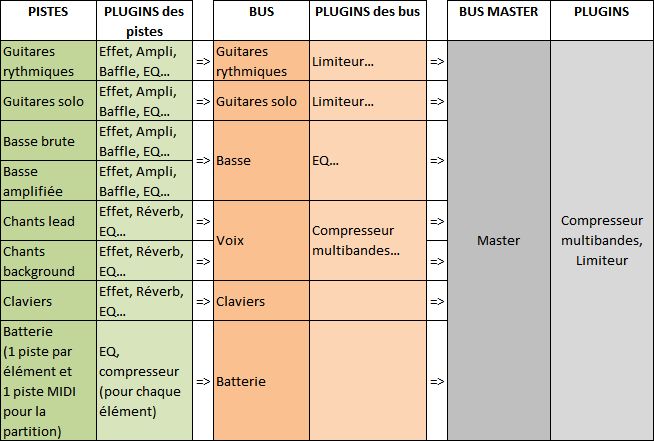





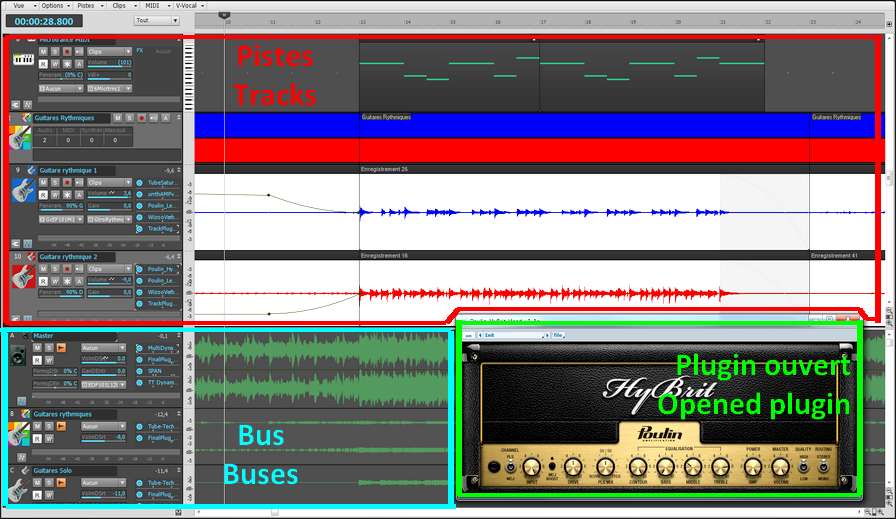


Recording an acoustic real drum kit is far from being easy, even for professional sound engineers. It a time-consuming process, it's frequent to spend several hours placing the microphones around the drum elements before you can actually record. But we are in a home studio, and we will have to deal with a software drum kit, based on midi files...
First of all, why start with the drums? The answer is simple, we will use drums as a metronome. The drums sound will guide us and help us follow the tempo. This will allow for an even recording and the song will not speed up or slow down unintentionally. Of course, variations can be interesting and bring some life to an otherwise mechanical tempo, but let's consider that a studio session seeks recording perfection, even though it's only a home studio.
I usually have no idea what my final drum track will sound like. Actually, I only adjust it when the rest of the song is finished. But I still need its metronome function to record all other instruments. Thus, I create a drum track which repeats itself over and over again, and I try to have this loop match what I am about to play (no punk rhythm to record a ballad). For instance, I'll use one of these patterns:
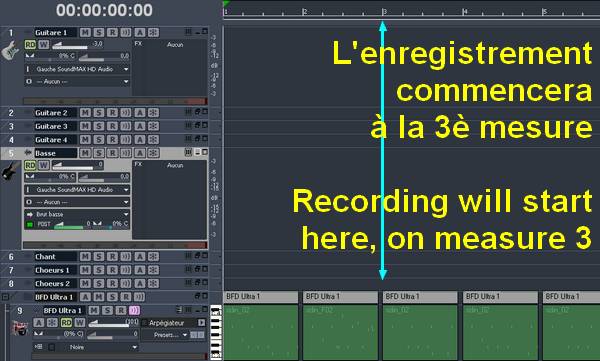

Let's not forget we are recording in a home studio, in an appartment and it is simply impossible to play with a good old 100-watt tube amplifier, without the neigbors calling the police. So we are going to have to record the guitars and the bass directly through the audio interface. No real amplifier, no microphones involved. The latter solution would be preferable, but on of the benefits of direct recording, coupled with amplifier simulators, is that you can always edit the sound later, without having to re-record. Just change the settings and you're done.
So now... bass or guitars first? There isn't one clear answer. Bass and drums are the foundation, the rhythm base of a song and everything else should rely on them. But other factors could also be taken into consideration: for instance, the person recording may be more comfortable with a guitar than a bass, and will rather play guitar first. Or maybe the song has a very important bass riff that compels you to record it first. In any case, you are the one who can decide. If you are uncertain, then the drum / bass duo is a safe bet. If this is in place, then the rest can easily be added.
Guitar or bass, the recording process will be the same. Plug your guitar into the pre-amp, the pre-amp is connected to the audio interface (or plug your guitar directly into the audio interface if using the interface's pre-amp), and set the recording level. This is very important! Before recording anything, check that you are not going to go beyond the maximum level (0 dB, zero decibel). In a home studio, you won't have a sound engineer besides you to make adjustments on the fly, while you are playing. You are the one to take precautions. How can you do that? Simple: try and adjust, it doesn't take long and will prevent you from making a perfect take, then realize the levels were too low or too high, forcing you to do it all over again.
Have a try: for a rhythm guitar for example, play the loudest parts and set the preamp and audio interface volume levels in such way that when you play the loudest, the recording level doesn't go beyond -6 dB. The absolute maximum that you should not reach or go beyond is zero dB. If you play in your try the same way you play during the actual recording, then you can be certain the recording level will be correct. If your average level is between -9 db and -6 dB, then your level is sufficient and you have a margin of error before clipping.
Clipping is the term used to indicate that you reach or go beyond 0 dB. Clipping is your enemy :-)
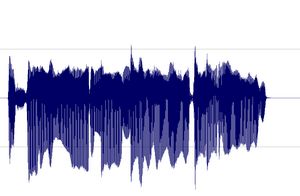
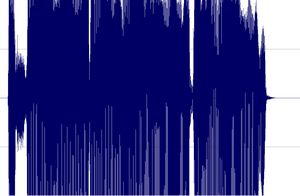
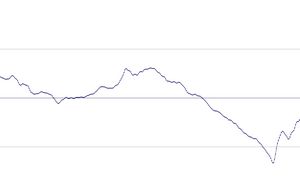
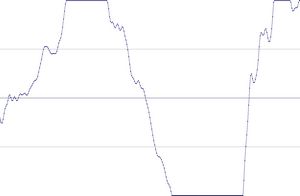

I prefer to record them last but there are no rules. If you prefer to record them first, then do so.
To record vocals, make sure the place is quiet, shut the door, tell the people who live with you to be quiet, and do not record while your neighbor is drilling holes through his kitchen walls! Also, turn off your monitors and use a headset instead to avoid recording the playback with your microphone.
Condenser or dynamic microphones?
Dynamic microphones are solid, they don' need a power source, they can take heavy acoustic pressure (like a kick drum or a saxophone) and they are not too expensive. They are also less sensitive to surrounding noises than condenser microphones. The cons are they lack clarity in the high range, which renders takes less clear and defined than with condenser microphones. They can be used with Jack or XLR plugs.
Condenser microphones are much more responsive and accurate. Their high sensitivity is double-edged, because they will capture any noise when recording. The fans of your PC are noisy? Chances are this noise will be recorded. Sound comes out of your headset? It will be recorded by your condenser microphone. Children are loudly playing outside? You might get that too. However, some condenser microphones are called "cardioid", or "hyper cardioid", and they only record what comes from a specific direction, ignoring (more or less) other sound sources from other directions. On the contrary, omnidirectional microphones record what comes from anywhere. Not ideal for a home studio. Condenser microphones are also more fragile (don't knock them) and must be powered through a "phantom power", whose standard is 48 volts. This kind of power is either present on your audio interface and can be turned on and off with a button, or it will require the use of an external phantom power source that you will then connect to your audio interface. You have to use 3-pin XLR plugs that carry the phantom power current. Finally, condenser microphones are usually rather expensive, some of them cost several thousand euros (or dollars, or pounds), but only professional studios or rich amateurs can afford those. On the plus side, the sound you get with a condenser microphone will have the best quality.
Be cautious though, a good dynamic microphone is worth better than a bad condenser microphone. No big secret here, for microphones like for anything else, very low prices are rarely synonymous with good quality.
A few known and renowned microphone brands: AKG, Milab, Neumann, Rode, Sennheiser, Shure...
Some pieces of advice: buy a microphone stand and a pop filter (you can also make one yourself with wire and a piece of tights from your wife / girlfriend / mother / daughter / neighbor). The stand will prevent you from manually holding your microphone and thus produce handling noises. As for the pop filter, it prevents the air to hit the microphone and produce unwanted blowing sounds when you pronounce some letters such as "p" or "b".
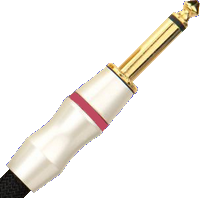
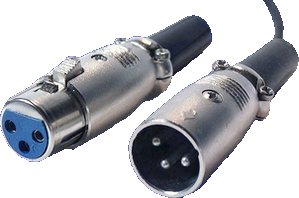
Jack plug (left) and XLR (right)
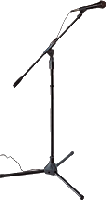


No need to go on and on forever, recording is rather easy. As long as you pay attention to your recording levels and take care over your takes, you should get a satisfying result, good enough to finalize the song

Messages page # 1 2 3 4 5 6 7 8 9 10 11 12 13 14 15 16 17 18 19 20 21 22 23 24 25 26 27 28 29 30 31 32 33 34 35

zico73
le 13/07/2011 à 21h29
Excellent site !!
J'ai beaucoup appris en lisant tout ceci.
Merci beaucoup !
Je vais essayer d'appliquer maintenant mais je pense que je reviendrai vers toi pour te poser quelques questions car il y a des choses que je n'ai pas bien saisies et qui méritent d’être éclaircies.
Bonne continuation. Musicalement,
Christophe
* * * * * * * * * * * * * * * *
<em>Content que ça puisse aider. À bientôt !
Grebz</em>

Ghis
le 16/06/2011 à 22h49
Hello !
C'est en cherchant un moyen d'utiliser mon ampli comme enceinte à relier à un ordi que j'ai trouvé ce site. Il m'a l'air très sympa et je le regarderai plus sérieusement pour faire des enregistrements moi-même (le pied !) plus tard.
Pour l'heure les études m’empêchent de m'y mettre à fond et l'on m'a confié la dure mission de résoudre un problème de sono pour une fête qui arrive début juillet (l'anniversaire de ma môman).
j'aurai donc juste une question (qui semblera insolente si la réponse se trouve bien évidemment sur ce site - mille excuses d'avance) : peut-on utiliser l'ampli (j'ai un Behringer V-amp combo) en simple baffle relié à un ordinateur tout bête à l'aide d'un simple câble. Et si oui... quel câble !!?
En remerciant d'avance pour la réponse et sinon bonne continuation.
Ghis
* * * * * * * * * * * * * * * *
<em>Bonjour et bienvenue,
A priori, tu devrais pouvoir y arriver en reliant la sortie casque de ton PC et une entrée auxiliaire sur ton ampli. En espérant qu'il y a bien une entrée "Aux" sur l'ampli. À l'arrière probablement. C'est sans doute une prise jack.
Il te faudrait idéalement un câble mini-jack stéréo / jack stéréo. (prise de type casque baladeur à un bout et gros jack à l'autre) MAIS on ne trouve que des câbles mini-jack stéréo vers double jack mono (un embout d'un côté, et deux embouts de l'autre), donc à moins d'avoir 2 entrées Aux Left et Right sur ton ampli, tu n'auras que la moitié du son.
Et honnêtement, je ne suis pas sûr que tu obtiennes un bon résultat. Les amplis guitare n'ont pas vraiment un son génial si tu y branches autre chose qu'une guitare. De la musique là-dedans, ça risque d'être assez moche.
Et si l'ampli est mono, la musique sortira en mono également. Un peu dommage si tu as prévu de faire danser les gens par exemple.
Bref, si tu as la prise qu'il faut sur ton ampli, c'est faisable, mais le résultat ne sera sans doute pas à la hauteur de tes espérances.
Il vaudrait mieux un ampli hifi et des enceintes hifi, bien sûr. Fais un essai. Un câble mini-jack / jack, ça doit coûter une poignée d'euros. Dans tous les cas, inutile de prendre un câble cher, un câble sans marque fera l'affaire, c'est pas de la haute fidélité.
Grebz</em>

LARYCRAFT
le 10/05/2011 à 04h39
Merci pour ce site très bien conçu, une mine d'or pour les maoistes en mal de conseils.
* * * * * * * * * * * * * * * *
<em>Merci beaucoup !
Ouais, Mao et moi, on est comme les doigts de la main :-)
Grebz</em>

morgan75
le 07/05/2011 à 18h51
Rebonjour,
Je viens de prendre connaissance de ton message. Donc si j'ai bien compris, l'nterface audio M-Audio livrée avec ProTools sera suffisante pour enregistrer quelques pistes de guitare ?
Je te remercie de tes réponses.
Amicalement,
Morgan
* * * * * * * * * * * * * * * *
<em>Oui, c'est bien ça. Le seul point négatif, c'est ProTools. Attention, ProTools est un outil connu et reconnu, je ne le dénigre pas du tout, mais je ne suis pas sûr qu'il sache utiliser de base (c'est à dire sans une extension spéciale, probablement payante) tous les plugins au format VST, comme ceux dont je parle sur mon site. Toutefois, je n'en suis pas certain, mais c'est un point à vérifier absolument.
Le format d'extension de ProTools, c'est le RTAS. Or, les RTAS gratuits sont bien moins répandus que les VST gratuits. C'est un point très important à considérer, à moins que tu ne sois prêt à dépenser pas mal d'argent en plugins.
Comme je l'ai dit, pour avoir un bon séquenceur pas cher, il y a <a href="http://www.reaper.fm/" target="_blank">Reaper</a> (40 dollars, soit moins de 30 euros), mais on peut le télécharger et l'utiliser 30 jours gratuitement. Après, l'utilisateur est prié de passer à la caisse, mais le logiciel continue d'être fonctionnel. À chacun de choisir de payer ou non, donc, mais si le logiciel convient, il est honnête de payer, surtout à ce prix-là. C'est à mon avis un bon choix. C'est en tout cas bien moins cher que Cubase ou Sonar.
Quoi qu'il en soit, la carte M-Audio, que tu te serves ou non de ProTools, est un bon choix. Il y a mieux, mais c'est plus cher et pas forcément utile pour commencer.
Bons enregistrements à toi !
Grebz</em>

morgan75
le 01/05/2011 à 16h10
Hey !
J'aimerais avoir un petit renseignement : comment relier mon ampli de guitare (marshall 15 watts mg fx ) à un ordi ? Faut-il un matériel spécial ? Je pensais à <a href="http://www.sonovente.com/m-audio-mobilepre-mkii-cartes-son-interfaces-p26091.htm" target="_blank">cela</a>, vendu avec le logiciel Protools ! Que faire ? Je souhaiterais enregistrer quelques morceaux... Merci de ton aide !
Cordialement,
Morgan
* * * * * * * * * * * * * * * *
<em>Bonjour,
L'équipement que tu indiques est une interface audio, c'est à dire une carte son. Mais ces interfaces audio, contrairement aux habituelles cartes son intégrées dans les PC, permettent d'obtenir une meilleure qualité de son, de diminuer la latence, et aussi de brancher des prises micro (format XLR) ou instruments (format jack). La latence, pour simplifier, c'est un retard qui se produit entre le moment où tu joues ta note sur un instrument, et le moment où tu l'entends dans les enceintes reliées à l'ordinateur. Cette latence est très gênante lors de l'enregistrement. Pour enregistrer une voix ou un instrument dans de bonnes conditions, une interface audio de qualité correcte est indispensable. J'en cite quelques-unes <a href="http://www.grebz.fr/musique_homestudio_tutorial_required_2.php#interface" target="_blank">ici</a>. M-Audio est plutôt une bonne marque, a priori, pas de souci.
Pour enregistrer une guitare,voilà ce qui tu as comme solutions :
1 - Enregistrer en direct : tu branches ton jack de guitare dans ton interface audio. L'interface contient un préampli de plus ou moins bonne qualité selon l'interface utilisée, qui permet d'amplifier le son à un niveau correct. Ou bien ajouter un <a href="http://www.grebz.fr/musique_homestudio_tutorial_required_2.php#preamp" target="_blank">préampli</a> entre la guitare et l'interface audio pour amplifier encore plus si besoin. Mais cela veut dire que tu n'utilises pas ton ampli de guitare, et donc que tu devras ajouter des simulateurs d'ampli dans ton séquenceur. L'avantage est que c'est moins bruyant qu'un ampli de guitare.
2 - Tu branches la sortie casque de ton ampli à l'interface audio (ou préampli + interface audio) et tu enregistres donc le son qui sort de la prise casque. Je ne sais pas si le son sera génial de cette manière, mais si tu as une prise casque, ça devrait marcher.
3 - Tu achètes un micro correct et tu le places devant ton ampli. Tu joues avec ton ampli et tu branches le micro sur l'interface audio (ou préampli + interface audio). Le micro va donc enregistrer ce que tu joues. À toi de bien placer ton micro pour obtenir le son désiré. L'emplacement est très important. Il suffit de bouger le micro de quelques centimètres pour obtenir un son différent. Tu peux d'ailleurs faire plusieurs prises en plaçant le micro différemment à chaque fois et obtenir un son plus riche en superposant les prises obtenues dans différentes pistes du séquenceur. Un bon micro pour commencer, pas trop cher pour enregistrer un ampli de guitare, c'est le <a href="http://www.grebz.fr/musique_homestudio_tutorial_required_2.php#microphone" target="_blank">Shure SM57</a>.
Enfin, pour le séquenceur, ProTools est un bon logiciel, très réputé (et que je n'aime pas trop à titre personnel, mais bon... on s'en fout). S'il est fourni (sans doute dans une version "light") avec l'interface audio, ça fait toujours ça de moins à acheter. Sinon, tu as Reaper, très bon logiciel pas très cher. Après, tu as Sonar ou Cubase, par exemple, qui fonctionnent tous sur les mêmes principes, mais ces logiciels ne sont pas donnés.
Grebz</em>
